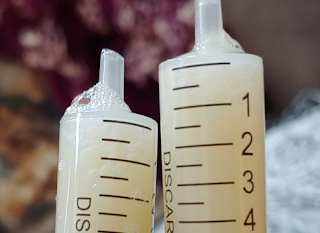When you are nearing the conclusion of your pregnancy, it is possible that your breasts will begin to secrete a milky fluid that is clear, golden-yellow or light orange in color. Colostrum is the term used for this. It's also known as "liquid gold" and "first milk," by certain individuals.
Colostrum is a dense, gloopy, and viscous milk that is the first milk that you produce when you start breastfeeding. It is jam-packed with antibodies and probiotics that help to jumpstart your baby's virgin gut and underdeveloped immune system.
It is produced in minute quantities, yet a little goes a long way in helping your newborn acclimatize to life after birth. Because of its laxative effects, it can even assist your infant in passing their first stool (meconium).
If you notice any leakage from your nipples when you are pregnant, this most likely is colostrum milk. After 36 weeks, you can start the process of collecting colostrum.
Colostrum harvesting Pros
After giving birth, the production of breast milk can be difficult for a lot of women for a variety of reasons that are beyond their control.
Because experts believe that prenatal harvesting of colostrum helps to "light up" the milk ducts, increases the passage of colostrum, and increases the chances of regular milk production, it can be beneficial for women who have undergone breast surgery, have battled with illness, or who naturally have a low milk production. These women can indeed benefit from prenatal harvesting of colostrum. Your infant can still receive colostrum if you are not able to nurse immediately away.

If you have a baby that needs supplemental feeding, having a supply of colostrum available can be really helpful and advantageous in this situation. Supplemental feeding may be necessary if: 1) Your infant develops low blood sugar. 2) Your infant exhibits dehydration symptoms. 3) Your infant is underweight at birth or is losing weight too soon. 4) You've had breast surgery in the past or your breasts are underdeveloped.
Natural components in colostrum make it a potent, secure laxative for infants, assisting them in passing their first feces (meconium). Colostrum supplementation is frequently helpful in preventing or treating jaundice since meconium includes bilirubin, which can lead to it.
Colostrum harvesting Cons
According to the National Health Service (NHS), there is no evidence to suggest that hand expression of colostrum can induce labor in mothers who are not known to be at risk of going into labor before their due date. However, you should cease the expression of breast milk if you feel any contractions in your uterus while you are doing so.
Slowing the flow will make nursing easier for your infant. Some moms express a small amount of breast milk by hand to reduce the flow before bringing the infant to the breast; however, if this is done repeatedly, it might cause oversupply.
Frequently Asked Questions (FAQ's)
What is the right time to start harvesting colostrum?
Colostrum should be harvested between 36 and 37 weeks of pregnancy. S some pregnant women could start noticing colostrum leakage as early as week 16 of their pregnancy.
Can I use a pump for colostrum harvesting?
Colostrum can also be collected during pregnancy by hand-expression in the same manner that would be used after the baby is born to gather breast milk for the new-born. When you are pregnant, the only method of expression that should be used is your hands. You shouldn't start using a breast pump until after the baby has been born.
How many syringes of colostrum should I collect?
Colostrum collection requires a 1ml syringe and a label for each collection. Before you begin, make sure that your hands are clean by washing them with soap and hot water, and then drying them off.







0 Comments
For comments please reply here.......